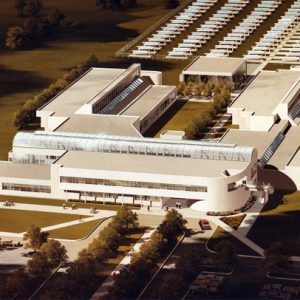calsfoundation@cals.org
Mississippi County Community College Solar Power Experiment
In 1976, the Department of Energy and the Solar Energy Research Institute were allotted funds for a Total Energy Solar Photovoltaic Conversion System that would be the largest of its kind in the world. The location chosen for the project was Mississippi County Community College (MCCC), now Arkansas Northeastern College (ANC), in Blytheville (Mississippi County). The project design included the installation of solar panels, as well as additional funding for the college facility. The main purpose of the project was to build an energy-efficient structure and harness solar power from the panels in order to coordinate, monitor, and manage energy production.
With the United States facing an energy crisis in the mid-1970s, President Jimmy Carter created a comprehensive energy plan that included the research and development of solar energy. The Total Energy Solar Photovoltaic Conversion System was originally intended to power MCCC by generating both electricity and hot water. The college, which had been established in 1975, needed a facility, and the project provided both an important experimental tool, as well as a campus for the new college.
The Department of Energy issued a grant for $6.3 million for the project, which was supplemented by a local bond issue that brought the total to $8.8 million. A total of 270 single-axis tracking concentrating collectors were installed, each measuring 20’x7′. The project was also designed to store excess energy in an iron-redox electrical storage system, but this was eventually rejected because of cost and time constraints. The college negotiated a contract with a local utility provider, Arkansas-Missouri Power Company (now Entergy), for an exchange of excess electricity generated over the weekend.
The college building was designed to be energy efficient. The main concourse and two wings were covered with vaulted glass ceilings that could be used for solar shading and were covered with wind-breaking devices. Classrooms and offices were designed to make efficient use of natural lighting. Solar cells located on the panels heated a coolant that ran into huge underground tanks and were used for space heating and to heat the water supply. The entire system was controlled by one of the first Hewlett-Packard desktop computers, while a second computer collected data for the National Data Bank located in Seattle, Washington.
The Department of Energy agreed to support and maintain the operation for a five-year period in 1982. However, the Ronald Reagan administration slashed numerous alternative energy programs in the early 1980s. The Solar Energy Research Institute lost most of its funding, eventually becoming the National Renewable Energy Laboratory. With the MCCC solar panel project funding cut, the project was shut down in October 1983. The Energy Department justified its decision based on low energy output and the high cost of maintaining the facilities. Although the college was never completely solar powered, the panels were still used for a few years to heat the school’s water. Eighty percent of the solar panels were removed and sold for scrap metal beginning in 1998. The last remaining examples, with the exception of one, were removed in 2005. The last solar panel stands beside a plaque commemorating the Mississippi County Community College Solar Power Experiment. The data collected from this experiment has been used in subsequent years by numerous countries who have invested in alternative energy sources.
For additional information:
Johnson, Russell T. “Mississippi County Community College Solar Project.” Arkansas Roadside Travelogue. http://arkansasroadstories.com/engineering/mccc.html (accessed September 15, 2023).
Smith, Harry. “The World’s Largest Photovoltaic Concentrator System.” Planning for Higher Education 10 (Winter 1982): 22–24.
“A Total Energy Solar Photovoltaic Conversion System for Mississippi County Community College: A Proposal to the Energy Research and Development Administration.” Blytheville, AR: Mississippi County Community College, 1976.
Jillian Hartley
Arkansas Northeastern College
 Divergent Prosperity and the Arc of Reform, 1968–2022
Divergent Prosperity and the Arc of Reform, 1968–2022 Science and Technology
Science and Technology Mississippi County Community College Solar Power Experiment
Mississippi County Community College Solar Power Experiment  Mississippi County Community College Solar Power Experiment
Mississippi County Community College Solar Power Experiment  Mississippi County Community College Solar Power Experiment
Mississippi County Community College Solar Power Experiment  Mississippi County Community College Solar Power Experiment
Mississippi County Community College Solar Power Experiment 




Comments
No comments on this entry yet.